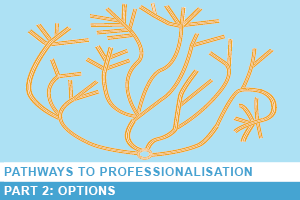Pathways to professionalisation - Part 2: Options for professionalisation
In the previous blog in this series, greet Peersman and Patricia Rogers introduced the ‘Pathways to advance professionalisation within the context of the AES’ project and report.
A major feature of this report is the exploration of 41 activities and approaches that can be used to advance the professionalisation of monitoring and evaluation, and the conclusion of this two-part series looks at these approaches in more detail. We believe these activities are likely to be of considerable interest to others who are undertaking or planning evaluation capacity strengthening activities and we encourage you to share your feedback and thoughts on these activities at the end of this blog.
In part 1 of this blog series, we introduced the ‘Pathways to advance professionalisation within the context of the AES’ project and report, which we conducted for the Australasian Evaluation Society. Our recommendation was to follow a pathway of focused, connected and strategic activities, with a view to considering a voluntary credentialing process down the track, but avoiding a regulated, licensed profession.
One of the features of the report, Pathways to Advance Professionalissation within the context of the AES is the discussion of 41 approaches that can and have been used for professionalisation in evaluation and in other related fields. The diagram below highlights how these activities fit in with what the AES is currently doing, and what we recommend they start to do, and you can read more about these recommendations in our last blog and associated report.
Figure 1. Pathway 2: START focusing, connecting and augmenting current activities

Our report is only the starting point or the initial input to a consultative and collaborative process led by the AES leadership and committees. The AES’ board has accepted the report’s recommendations and the AES has already started mapping a way forward for pathway 2. The first stage of this includes consultation, and the AES will host a webinar in August for AES members to give input on this strategy (details to be announced).
We believe these activities are likely to be of considerable interest to others who are undertaking or planning evaluation capacity strengthening activities.
The full list of activities serves as a reminder that we have a lot of tools at our disposal for increasing the quality of evaluation. Too often, we reach for only a few of them, most notably, brief training courses that are disconnected from people’s practical experiences. We can make a much bigger impact if we focus on a complementary mix of approaches that address not only the individual capacity and motivation of evaluators (supply) but, importantly, also the opportunities for evaluation (demand and enabling environment).
We have grouped these activities into four broad change theories, drawing on the three included in Susan Mitchie’s Behaviour Change Wheel: motivation, capacity, and opportunity, and adding gatekeeping. We’ve also added a number of these to the site in our newly revised Strengthen Evaluation Capacity task page in the Rainbow Framework, and linked to these new option pages in the list below.
Jump to:
Change Theory: INCREASING MOTIVATION – Active contribution to a valued occupational identity
1. Reference points for professional practice:
1.1 Code of conduct
1.2 Competencies
1.3 Distinct occupational category
1.4 Expectation of ongoing competency development
1.5 Standards
2. Engagement with other professional associations:
2.1 Evaluation associations
2.2 Other professional associations
3. Public recognition of good practice:
3.1 Awards
3.2 Fellows
3.3 Voluntary credentialling
Change Theory: INCREASING CAPACITY – Ongoing and linked professional development and support
4. Competency assessment
4.1 Peer-assessment
4.2 Self-assessment
5. Knowledge, skills, attitudes (KSA) development
5.1 Dialogues
5.2 Peer learning
5.3 Self-paced learning
5.4 Training (accredited or not)
6. Ongoing competency development
6.1 Coaching
6.2 Expert advice
6.3 Expert review
6.4 Fellowship
6.5 Internship
6.6 Mentoring
6.7 Peer review
6.8 Supervision
7. Building and sharing knowledge
7.1 Community of Practice
7.2 Conference
7.3 Journal
7.4 Learning partnerships
7.5 R&D projects
Change Theory: INCREASING OPPORTUNITY – Better informed and motivated demand side of evaluation and enabling environment
8. Educating the public and evaluation managers and users:
8.1 Public information about evaluation
8.2 Public information about professional practice
9. Strengthening the enabling environment for good evaluation practice:
9.1 Engagement in relevant organisational processes
9.2 Engagement in relevant public processes
Change Theory: GATEKEEPING - Controlling entry to the field and removing those breaching agreed professional standards or code of conduct
10. Restricting entry
10.1 Compulsory accreditation
10.2 Compulsory certification
10.3 Compulsory credentialling
10.4 Hurdle requirements for consultants register
10.5 Hurdle requirements for membership
10.6 Licensing
11. Detecting and correcting poor quality practice or unethical conduct
11.1 Complaints procedure
11.2 Disciplinary action
Related content
'Pathways to professionalisation - Part 2: Options for professionalisation' is referenced in:
Blog
